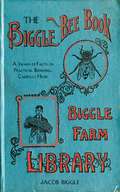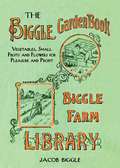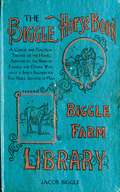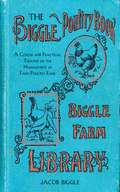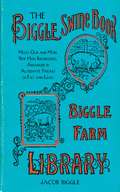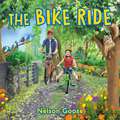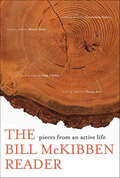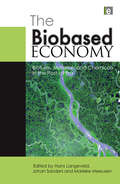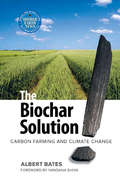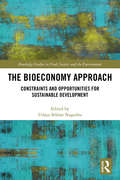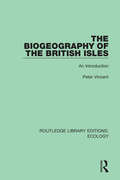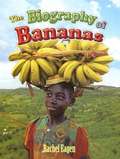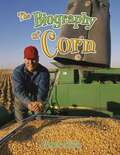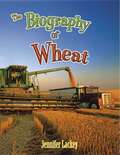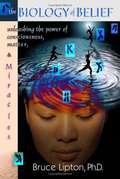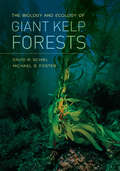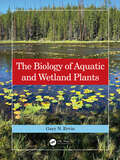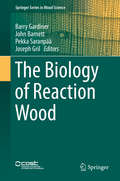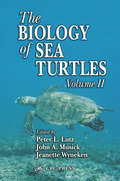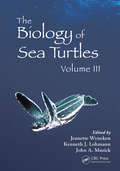- Table View
- List View
The Biggest Snowball Fight!
by Angela Shelf MedearisA snowball fight leads to a new dance and starts a new town tradition. picture descriptions added.
The Biggle Bee Book: A Swarm of Facts on Practical Beekeeping, Carefully Hived
by Jacob Biggle"As long as I can remember, even as a boy, there were bees kept on our farm," wrote Jacob Biggle in his preface to The Biggle Bee Book. "If for no other reason than to insure the proper fertilization of fruit and other blossoms, every farmer, fruit grower, or gardener should keep a few bees upon his grounds." Biggle's fifty colonies of bees, though requiring just a small part of his time, paid Biggle a larger return than any other animal on his farm. Not only did he take pleasure in caring for these wonderful insects and enjoying the honey they produced, he also recognized that their presence on his farm meant that his orchards and crops would flourish.If there are any so-called secrets to the art of beekeeping, Jacob Biggle does his best to expose them all in this delightful little volume. His hope was that readers could profit from his hard-earned wisdom that included:The benefits of keeping beesHow to care for bees through the winterThe marketing and selling of wax- and honey-based productsWhat bee-friendly plants to raise in the gardenHow to introduce a new queen to the hiveWritten not only for the professional beekeeper, but also for the backyard farmer, and anyone interested in rural life, self-sufficiency, and farming techniques of the past, this book is an essential addition to the home library.
The Biggle Garden Book: Vegetables, Small Fruits and Flowers for Pleasure and Profit (Gardening In America Ser.)
by Jacob BiggleWhen The Biggle Garden Book was first published in 1908, most people were in the habit of raising their own food and flowers. Jacob Biggle felt that a gardener's success had to do with willpower and passion rather than acreage. "The man, woman or youngster who really wants a garden, will somehow manage to have a good one regardless of soil conditions, bad weather, measles in the family, or whether the area of ground at hand is a square acre or a square rod," he wrote encouragingly at the start of the book.That passion for gardening continues today in fields, backyards, and urban community plots across the United States. According to a poll taken in 2009 by the National Gardening Association, more than forty-three million households in the United States grow some of their own food. Learn how to do things the "old-school" way as Jacob and Harriet Biggle guide you through the fundamentals of:Soil preparation, sowing, and plantingHotbeds and cold framesFertilization, cultivation, and irrigationFlower gardening with old-fashioned favoritesGarden pests and friendsWith a resurgence in organic farming, heirloom varieties, and self-reliant living, The Biggle Garden Book is more valuable than ever because of the time-tested advice it offers.
The Biggle Horse Book: A Concise and Practical Treatise on the Horse, Adapted to the Needs of Farmers and Others Who Have a Kindly Regard for This Noble Servitor of Man
by Jacob Biggle"People ought to try to make their horses happy," wrote Jacob Biggle's wife Harriet in The Biggle Horse Book in 1894. "A happy, cheerful horse will do more work and live longer, and thus be more profitable to its owner, than one whose temper is kept constantly ruffled, whose disposition is soured by ill-usage, and whose peace of mind is often disturbed by the crack of the whip, the hoarse voice of the driver, the strain of overwork, the discomfort of a hard bed, or the pangs of hunger and thirst." When it comes to the treatment of animals--especially the horse--the Biggles were ahead of their time.Folksy and informative, this manual offers timeless tips on the effective and humane treatment and training of horses and detailed descriptions of all the major breeds. Practical horsemen and veterinarians of the era contributed their wisdom and insight, and their maxims on owning, riding, and working with horses will provide endless hours of entertainment. Here are just a few:"Proper food and lots of sentiment will make with good blood a good horse.""If you must put frosty bits in some mouths, let it be your own. Suffering begets sympathy.""The three greatest enemies of the horse are idleness, fat, and a dumb blacksmith.""Don't try to fit a horse to the collar. It won't work. Fit the collar to the horse."Enhanced with beautiful engravings, illustrations, and snippets of poetry throughout, The Biggle Horse Book remains a loving and fitting tribute to "this noble servitor of man."
The Biggle Poultry Book: A Concise and Practical Treatise on the Management of Farm Poultry
by Jacob BiggleWhen Jacob Biggle first published his book on the management of poultry, there were more than 300 million chickens and 30 million other domesticated fowl in the United States. Today, the trend continues with thousands if not millions of chickens and other fowl being raised in suburban and urban backyards across America. Biggle's aim was to "help farmers and villagers conduct the poultry business with pleasure and profit." To that end, this handy little volume contains all the information the reader needs to know, such as:The various breeds of chickens, turkeys, guinea fowl, ducks, geese, and pigeonsThe most common diseases and enemies that threaten our feathered friendsRaising hens expressly for eggs rather than meatThe farmer's flock versus the village henneryThe art of hatching eggs and caring for chicksWritten for the practical farmer who raises poultry and eggs for market,The Biggle Poultry Book will also appeal to collectors of farm ephemera and anyone else who is nostalgic for a simpler way of doing things. Illustrated with sixteen color plates by Louis P. Graham, and hundreds of black-and-white photographs and illustrations throughout, The Biggle Poultry Book is as beautiful as it is useful and a treasure for the home library.
The Biggle Swine Book: Much Old and More New Hog Knowledge, Arranged in Alternate Streaks of Fat and Lean
by Jacob BiggleWhen Jacob Biggle first published The Biggle Swine Book in 1898, hog husbandry was undergoing major changes. New feeding methods had come into vogue, new breeds of hogs had been developed, and significant progress had been made in curbing swine-borne epidemics. Even the public perception of pigs as filthy creatures wallowing up to their knees in mud had brightened, and pigs were accorded a modicum of respect. But with the onset of railroad development across the United States, the backyard pig farmer started losing ground to slaughterhouses and large processing plants.The Biggle Swine Book captures this moment in American history when home animal husbandry was giving way to more industrialized meat production. Nevertheless, Jacob Biggle continued to offer guidance to the small-scale farmer on all manner of livestock issues, centered around the proper breeding, feeding, and care of pigs. His book includes valuable instructions on: What to do at farrowing timeConstructing the piggery and styKeeping on top of the manure pileButchering and curing meatsProtecting your animals from various pig ailmentsIllustrated with photographs, engravings, and line drawings throughout of all things pig-related, this book is a glimpse into a bygone era when sows and their litters had a place on every farm, and people knew exactly where their bacon came from.
The Bike Ride
by Nelson GooseFrom the creative minds behind Reading Rainbow comes The Bike Ride, a charming picture book about one meaningful bike ride and our changing environmental landscape.Dave and his dad spend every summer at a house near the beach. And every day, they go on a bike ride. As they ride along, they see blue jays singing, squirrels scampering up trees, and their favorite place of all: a beautiful inlet overlooking the ocean, with a lighthouse in the distance.But one day, things change. A big yellow bulldozer is digging up trees, clearing the land to build something. Dave is worried about what will happen to the animals who live in those trees.Whimsical illustrations bring to life this story of ecological and emotional change as Dave finds clever ways to adjust—and makes a new friend.
The Bill McKibben Reader: Pieces from an Active Life
by Bill McKibbenPowerful, impassioned essays on living and being in the world, from the bestselling author of The End of Nature and Deep EconomyFor a generation, Bill McKibben has been among America's most impassioned and beloved writers on our relationship to our world and our environment. His groundbreaking book on climate change, The End of Nature, is considered "as important as Rachel Carson's classic Silent Spring"* and Deep Economy, his "deeply thoughtful and mind-expanding"** exploration of globalization, helped awaken and fuel a movement to restore local economies.Now, for the first time, the best of McKibben's essays—fiery, magical, and infused with his uniquely soulful investigations of modern life—are collected in a single volume, The Bill McKibben Reader. Whether meditating on today's golden age in radio, the natural place of biting black flies in our lives, or the patriotism of a grandmother fighting to get corporate money out of politics, McKibben inspires us to become better caretakers of the Earth—and of one another.*The Plain Dealer (Cleveland )**Michael Pollan
The Bin Laden Plot: A Novel (Trident Deception Series #7)
by Rick CampbellA U.S. destroyer is torpedoed by an Iranian submarine and Captain Murray Wilson of the U.S.S. Michigan is flown to the Pentagon to meet with the Secretary of the Navy (SecNav). There Wilson learns that the Iranian submarine is just a cover story. One of the United States' own fully automated unmanned underwater vehicles has gone rogue, its programming corrupted in some way. Murray is charged with hunting it down and taking it out before the virus that's infected its operating system can infect the rest of the fleet. At the same time, the head of the SEAL detachment aboard the U.S.S Michigan is killed and Lonnie Mixell, a former U.S. operative, now assassin for hire, is responsible. And that is only the first SEAL to be hunted down and killed. Jake Harrison, fellow SEAL, discovers that these SEALs had one mission in common - they were all on the team that killed Bin Laden. Or so the world was told. As Wilson discovers that his mission is actually meant to cover up dangerous acts of corruption, even treason, Harrison discovers that the assassin is out to protect the same forces. Forces too powerful for either of them to take on alone.
The Biobased Economy: Biofuels, Materials and Chemicals in the Post-oil Era
by Johan Sanders Marieke Meeusen Hans LangeveldThe impending threats of catastrophic climate change and peak oil are driving our society towards increased use of biomass for energy, chemical compounds and other materials - the beginnings of a biobased economy. As alternative development models for the biobased economy emerge, we need to determine potential applications, their perspectives and possible impacts as well as policies that can steer technological and market development in such a way that our objectives are met. Currently, it is still far from clear what will be the most sustainable routes to follow, which technologies should be included, and how their development will affect, and be affected by, research, public opinion and policy and market forces. This groundbreaking work, edited by a group of leading researchers originally from Wageningen Agricultural University in the Netherlands, sets out to unpick the complex systems in play. It provides an illuminating framework for how policy and market players could and should drive the development of a biobased economy that is effective, sustainable, fair and cost efficient. Starting with a state-of-the-art overview of major biobased technologies, including biorefinery and technologies for the production of biofuels, biogas, biomass feedstocks for chemistry and bioplastics, it discusses how different actor groups interact through policy and markets. Information from case studies is used to demonstrate how the potential of the biobased economy in different parts of the world, such as North America, Europe, and emerging economies like China and Brazil can be realised using research, debate, policy and commercial development. The result is an essential resource for all those working in or concerned with biobased industries, their policy or research.
The Biochar Solution
by Albert BatesConventional agriculture destroys our soils, pollutes our water, and is a major contributor to climate change. What if our agricultural practices could stabilize, or even reverse these trends?The Biochar Solution explores the dual function of biochar as a carbon-negative energy source and a potent soil-builder. Created by burning biomass in the absence of oxygen, this material has the unique ability to hold carbon back from the atmosphere while simultaneously enhancing soil fertility. Albert Bates traces the evolution of this extraordinary substance, from the ancient black soils of the Amazon to its reappearance as a modern carbon sequestration strategy.Combining practical techniques for the production and use of biochar with an overview of the development and future of carbon farming, The Biochar Solution describes how a new agricultural revolution can reduce net greenhouse gas emissions to below zero while increasing world food reserves and creating energy from biomass wastes. Biochar and carbon farming can:*Reduce fossil fuels inputs into our food system*Bring new life to desert landscapes*Filter and purify drinking water*Help build carbon-negative homes, communities, and nationsBiochar is not without dangers if unregulated, and it is not a panacea, but if it fulfills its promise of taking us back from the brink of irreversible climate change, it may well be the most important discovery in human history.
The Biodiversity Observation Network in the Asia-Pacific Region
by Shin-Ichi Nakano Tetsukazu Yahara Tohru NakashizukaBiological diversity is important for ecosystem function and services, which in turn is essential for human well-being. Under the Convention on Biological Diversity, international efforts have been made to achieve a significant reduction in the current rate of biodiversity loss. The loss continues, however. The Asia-Pacific region includes both developing countries with high biodiversity and developed countries with sophisticated data collection and analyses, but only limited information about the status quo of biodiversity in this region has been available. Many Asia-Pacific countries have rapidly grown their economies and social infrastructures, causing a loss of biodiversity and requiring an urgent mandate to achieve a balance between development and conservation in the region. In December 2009, scientists successfully organized the Asia-Pacific Biodiversity Observation Network in the region, to establish a network for research and monitoring of ecosystems and biodiversity and to build a cooperative framework. The present volume is the first collection of information on biodiversity in the Asia-Pacific and represents a quantum step forward in science that optimizes the synergy between development and biodiversity conservation.
The Bioeconomy Approach: Constraints and Opportunities for Sustainable Development (Routledge Studies in Food, Society and the Environment)
by Udaya Sekhar NagothuThis book examines the bioeconomy concept, analysing the opportunities it can generate, the constraints and the potential benefits for society. The main objective of bioeconomy is to promote economic development, by creating jobs and enhancing the sustainable utilization of bio-resources. A primary driver of bioeconomy strategy, therefore, is the need to respond to the growing population's food and economic requirements. While today research and literature related to bioeconomy are limited, this book presents a unique collection of perspectives on the complex dimensions of the bioeconomy debate. Drawing on the experiences from Europe, Asia and Africa, it presents an international overview. The chapters address a wide range of issues, including coastal-land interactions, ecosystem services, food production, rural development, agriculture, forest management and bioenergy. As a whole, the volume outlines what role bioeconomy can play in contributing to the United Nations Sustainable Development Goals (SDGs) without compromising on the ecological sustainability and equitable distribution of benefits. The book concludes by providing recommendations for developing bioeconomy in respective sectors (agriculture, forestry, fisheries, renewable energy) and directions for planning future bioeconomy programmes and strategies. The Bioeconomy Approach will be of great interest to students and scholars of ecological economics, development economics and environmental economics, as well as policy-makers and practitioners involved in sustainable development.
The Biogeography of the British Isles: An Introduction (Routledge Library Editions: Ecology #17)
by Peter VincentOriginally published in 1990, The Biogeography of the British Isles is devoted to the biogeography of the British Isles and surrounding shelf seas. Bringing together a wealth of diverse information, it is thoroughly referenced and well illustrated, and will be invaluable to students of geography, environmental science, ecology, botany, and zoology. The book traces the development of British biogeography over the last two centuries, examining key topics such as ecosystems, habitats, and niches in the context of plant and animal distribution. The book gives a detailed account of the development of biogeographical mapping and recording systems, and describes modern-day distributions, both in the countryside and in urban areas against the backcloth of human activities.
The Biography of Bananas (How Did That Get Here)
by Rachel EagenAlmost unknown in North America before the 1870s, bananas quickly became a popular fruit with a rough history. It was explained who grows your bananas, how they are harvested, and why the banana may soon become extinct.
The Biography of Corn (How Did That Get Here?)
by L. Michelle Nielsen L. Michelle NielsonMaize, or com, was the staple food of many early cultures in South America, Mesoamerica, and the Caribbean. <p><p>The Biography of Corn will teach young readers how the farming of corn spread to the rest of the world and how corn may be one answer to today's problem of fossil fuel consumption.
The Biography of Wheat (How Did That Get Here?)
by Jennifer LackeyThe growing of wheat as a staple food source made permanent settlements possible, particularly for settlers moving West. In this fascinating new book, children will learn how one of the world's most important food crops is grown, harvested, sold, and processed.
The Biology Of Belief: Unleashing The Power Of Consciousness, Matter And Miracles
by Bruce LiptonIn The Biology Of Believe Bruce Lipton explores celular development and how the environment plays a much more important roll in how life develops than conventional science ever thought. He challenges the belief that genetics control how we and all life develop and thrive ground breaking research. We once believed that the world was round but now marvel that anyone would have thought this. Bruce Lipton along with many micro biologist genetics are the blue print and plans but our environment and beliefs are the catolist that determine the quality of life.
The Biology and Ecology of Giant Kelp Forests
by David R. Schiel Michael S. FosterThe largest seaweed, giant kelp (Macrocystis) is the fastest growing and most prolific of all plants found on earth. Growing from the seafloor and extending along the ocean surface in lush canopies, giant kelp provides an extensive vertical habitat in a largely two-dimensional seascape. It is the foundation for one of the most species-rich, productive, and widely distributed ecological communities in the world. Schiel and Foster's scholarly review and synthesis take the reader from Darwin's early observations to contemporary research, providing a historical perspective for the modern understanding of giant kelp evolution, biogeography, biology, and physiology. The authors furnish a comprehensive discussion of kelp species and forest ecology worldwide, with considerations of human uses and abuses, management and conservation, and the current and likely future impacts of global change. This volume promises to be the definitive treatise and reference on giant kelp and its forests for many years, and it will appeal to marine scientists and others who want a better appreciation and understanding of these wondrous forests of the sea.
The Biology of Aquatic and Wetland Plants
by Gary N. ErvinAquatic plants play a critically important role in maintaining ecosystem health. They are natural biological filters in freshwater and estuarine wetlands; they contribute to the reproductive success of many organisms, some of which are harvested for food; they assist in flood control; and they are prominent elements in the aesthetics and recreational use of freshwater and estuarine habitats. Despite this globally recognized importance, wetlands have faced and continue to face threats from the encroachment of human activities. The Biology of Aquatic and Wetland Plants is a thorough and up-to-date textbook devoted to these plants and their interactions with the environment. The focus is on botanical diversity from the perspective of evolutionary relationships, emphasizing the role of evolution in shaping adaptations to the aquatic environment. By incorporating recent findings on the phylogeny of green plants, with special emphasis on the angiosperms, the text is broadly useful for courses in plant biology, physiology, and ecology. Additionally, a chapter on population biology and evolutionary ecology complements the evolutionary backdrop of hydrophyte biology by examining the details of speciation and applications of modern genetic approaches to aquatic plant conservation. Key Features • Synthesizes recent and seminal literature on aquatic and wetland plants • Emphasizes evolutionary history as a factor influencing adaptations to the wetland environment • Provides a global perspective on plant diversity and threats facing wetland ecosystems • Highlights research needs in the field of aquatic and wetland plant biology • Includes 280 figures, with more than 300 color photographs, and 41 tables to provide ease of access to important concepts and information
The Biology of Island Floras
by David Bramwell Juli Caujapé-CastellsOceanic islands offer biologists unparalleled opportunities to study evolutionary processes and ecological phenomena. However, human activity threatens to alter or destroy many of these fragile ecosystems, with recent estimates suggesting that nearly half of the world's insular endemics are threatened with extinction. Bringing together researchers from around the world, this book illustrates how modern research methods and new concepts have challenged accepted theories and changed our understanding of island flora. Particular attention is given to the impact of molecular studies and the insights that they provide into topics such as colonisation, radiation, diversification and hybridisation. Examples are drawn from around the world, including the Hawaiian archipelago, Galapagos Islands, Madagascar and the Macronesian region. Conservation issues are also highlighted, with coverage of alien species and the role of ex situ conservation providing valuable information that will aid the formulation of management strategies and genetic rescue programmes.
The Biology of Reaction Wood
by Barry Gardiner John Barnett Pekka Saranpää Joseph GrilThe book is a fundamental reference source on reaction wood for wood scientists and technologists, plant biologists, silviculturists, forest ecologists, and anyone involved in the growing of trees and the processing of wood. It brings together our current understanding of all aspects of reaction wood, and is the first book to discuss both compression wood and tension wood. Trees produce reaction wood to maintain the vertical orientation of their stems and the optimum angle of each branch. They achieve this by laying down fibre cell walls in which differences in physical and chemical structure from those of normal fibres are expressed as differential stresses across the stem or branch. This process, while of obvious value for the survival of the tree, causes serious problems for the utilisation of timber. Timber derived from trees containing significant amounts of reaction wood is subject to dimensional instability on drying, causing twisting, bending and splitting. It is also difficult to work as timber, and for the pulp and paper industry the cost of removing the increased amount of lignin in compression wood is substantial. This has both practical and economic consequences for industry. Understanding the factors controlling reaction wood formation and its effect on wood structure is therefore fundamental to our understanding of the adaptation of trees to their environment and to the sustainable use of wood. The topics covered include: -Morphology, anatomy and ultrastructure of reaction wood -Cell-wall polymers in reaction wood and their biosynthesis -Changes in tree proteomes during reaction wood formation -The biomechanical action and biological functions of reaction wood - Physical and mechanical properties of reaction wood from the scale of cell walls to planks -The detection and characterisation of compression wood -Effects of reaction wood on the performance of wood and wood-based products - Commercial implications of reaction wood and the influence of forest management on its formation
The Biology of Sea Turtles, Volume I (CRC Marine Science #12)
by Peter L. Lutz John A. MusickSea turtles have existed for millions of years, making them fascinating subjects of study. In the last 20 years, the science of sea turtle biology has expanded at an exponential rate, leading to major advances in many areas. This book synthesizes the results of these advances and focuses on how these endangered marine reptiles operate in, adapt to, and are dependent upon particular features of their marine environment. New technology in data gathering, such as DNA analyses, remote sensing, and physiological monitoring techniques, has led to a much greater understanding of the biology of the sea turtle at all stages of their life history.
The Biology of Sea Turtles, Volume II (ISSN #12)
by Peter L. Lutz John A. Musick Jeanette WynekenThe success of the first volume of The Biology of Sea Turtles revealed a need for broad but comprehensive reviews of major recent advances in sea turtle biology. Biology of Sea Turtles, Volume II emphasizes practical aspects of biology that relate to sea turtle management and to changes in marine and coastal ecosystems. These topics i
The Biology of Sea Turtles, Volume III (CRC Marine Biology Series)
by John A. Musick Jeanette Wyneken Kenneth J. LohmannSince the first volume of The Biology of Sea Turtles was published in 1997, the field has grown and matured in ways few of the authors would have predicted-particularly in the areas of physiology, behavior, genetics, and health. Volume III presents timely coverage of emerging areas as well as the integration of approaches and information that did n

